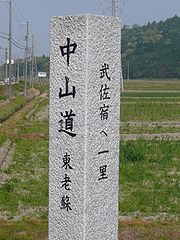
Musa-juku
Encyclopedia


69 Stations of the Nakasendo
The are the rest areas along the Nakasendō, which ran from Nihonbashi in Edo to Sanjō Ōhashi in Kyoto. The route stretched approximately and was an alternate trade route to the Tōkaidō.-Stations of the Nakasendō:...
of the Nakasendō
Nakasendo
The , also called the , was one of the five routes of the Edo period, and one of the two that connected Edo to Kyoto in Japan. There were 69 stations between Edo and Kyoto, crossing through Musashi, Kōzuke, Shinano, Mino and Ōmi provinces...
. It is located in the city of Ōmihachiman
Omihachiman, Shiga
is a city in Shiga Prefecture, Japan.The city was founded on March 31, 1954. In the quinquennial census of 2010, it had a population of 81,730...
, Shiga Prefecture
Shiga Prefecture
is a prefecture of Japan, which forms part of the Kansai region on Honshu Island. The capital is the city of Ōtsu.- History :Shiga was known as Ōmi Province or Gōshū before the prefectural system was established...
, Japan
Japan
Japan is an island nation in East Asia. Located in the Pacific Ocean, it lies to the east of the Sea of Japan, China, North Korea, South Korea and Russia, stretching from the Sea of Okhotsk in the north to the East China Sea and Taiwan in the south...
. Other kanji
Kanji
Kanji are the adopted logographic Chinese characters hanzi that are used in the modern Japanese writing system along with hiragana , katakana , Indo Arabic numerals, and the occasional use of the Latin alphabet...
used to write "Musa" included 牟佐 and 身狭, but 武佐 became the official kanji in the Edo period
Edo period
The , or , is a division of Japanese history which was ruled by the shoguns of the Tokugawa family, running from 1603 to 1868. The political entity of this period was the Tokugawa shogunate....
. Parts of the old post town still remain today, including the Nakamura-ya, a shop from the Edo period. There are also ruins from the sub-honjin
Honjin
thumb|250px|The honjin at [[Inaba Kaidō]]'s [[Ōhara-shuku]]. is the Japanese word for an inn for government officials, generally located in post stations during the later part of the Edo period.-Evolution of Honjin:...
remaining.
History
Records show that in 1843, Musa-juku had 537 residents and 183 buildings. Among the building, there was one honjinHonjin
thumb|250px|The honjin at [[Inaba Kaidō]]'s [[Ōhara-shuku]]. is the Japanese word for an inn for government officials, generally located in post stations during the later part of the Edo period.-Evolution of Honjin:...
, one sub-honjin, and 23 hatago
Hatago
were Edo period lodgings for travelers at shukuba along the national highways, including the Edo Five Routes and the subroutes. In addition to a place to rest, hatago also offered meals and other foods to the travelers...
.
The post station was also part of the Chōsenjin Kaidō
Chōsenjin Kaidō
The was a travel route during the Edo period in Ōmi Province, Japan. It received its name because it was used about 12 times by representatives of the Joseon Dynasty in modern-day Korea during the Joseon missions to Japan...
, a sub-route which connected the post station with Toriimoto-juku
Toriimoto-juku
was the sixty-third of the sixty-nine stations of the Nakasendō. It is located in the north of Hikone, Shiga Prefecture, Japan.Even today, there are remnants of the former post town around. If you enter from the north, you pass by a pine colonnade that leads to the still-standing buildings...
.

